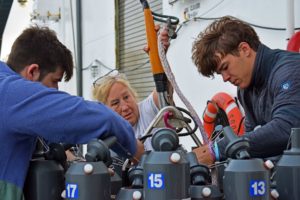

A "CTD" rosette with a suite of attached sensors is utilized on Regional Cabled Array OOI cruises to measure ocean properties and to collect fluid samples adjacent to the Shallow and Deep Profiler Moorings for instrument verification. The rosette includes conductivity-temperature-depth (CTD) sensors, dissolved oxygen, chlorophyll fluorescence, and a transmissometer to detect particles in the water column. During some cruises, these platforms also host a pH and Photosynthetically Active Radiation (PAR) sensor. Claire Knox, a student on the VISIONS13 Expedition produced a nice video describing a CTD and operations.
The CTD measures the salinity and temperature of seawater, which are fundamental properties needed to understand the physical structure of the ocean. A dissolved oxygen sensor measures the available oxygen present in the water, which gives clues to the ability of the ocean to sustain animal life. Chlorophyll fluorescence is a proxy for phytoplankton concentration and a transmissometer measures the amount of light absorbed or transmitted through water. pH is a measure of the total hydrogen ion concentration in the ocean. PAR sensors provide a measure of the amount of light available for photosynthesis by phytoplankton. The altimeter provides the distance above the seafloor.

The CTD is most commonly deployed within a carousel of Niskin Bottles, with watertight seals which can be triggered to close at selected depths for seawater collections. If time permits during the cruise, multiple vertical casts with the CTD package will be undertaken. Shipboard and follow-up shore-based analyses of fluids will be compared to the CTD on the ROV Jason and to instruments on the moorings to examine instrument calibration and drift. CTD casts are conducted prior to recovery of instruments on the mooring, and subsequent to re-installation.
